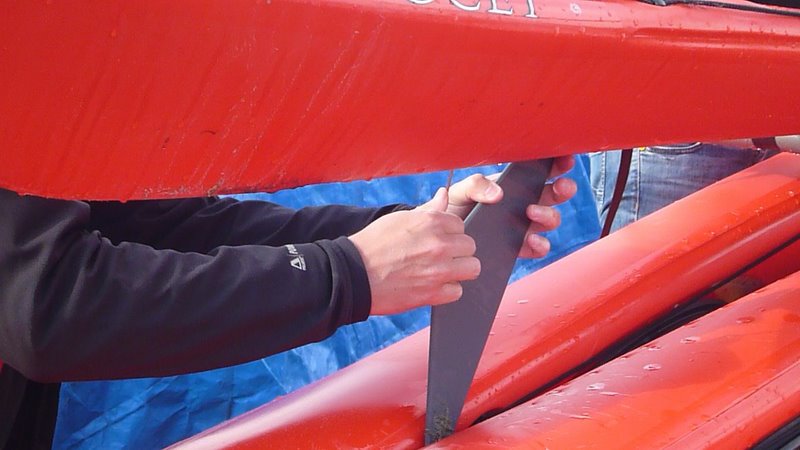With the Club’s fleet of sea kayaks fast approaching their first birthday the Scotland trip a few weeks ago presented an opportunity of giving them a bit of well earned TLC.
With some people moaning that their skegs were not working, upon inspection it was immediately apparent that most of the skegs were not in a very good shape at all – this was mainly due to the accumulation of silt and sand causing them to jam up, but there was evidence of misuse in a couple of instances.

A bit of a recap on what a skeg is and how to use them then…
Generally most sea kayaks when evenly loaded will weathercock – that is the front (bow) will turn into the wind. This is because it is generally anchored in the water whilst it is moving enabling the unanchored back (stern) to be blown downwind.
The skeg is a dropdown fin which if used correctly can provide extra resistance at the stern from being blow downwind making it easier to paddle in a straight line in windy conditions.
All the skegs in the Club’s sea kayaks are adjustable using a stainless steel braided cable to pull the skeg up into the recess in the stern or to push the skeg into the deployed position. This enables you to set it to the right depth in the water for the wind direction and strength. This requires fine tuning and is not a simple skeg up or skeg down exercise. Adjustments are made until the least amount of correction is required when paddling forwards in windy conditions.
When paddling into the wind the skeg is not required to maintain direction (i.e. skeg should be completely up), when paddling with the wind on the front quarter have it a quarter down (i.e. diagonally across the wind), when paddling across the wind it is halfway down, when paddling with wind on the rear quarter it is three-quarters down, and when paddling downwind the skeg is fully down. This is only a general guide you need to experiment as trim and kayak design will have an effect. On the recent Wallasea Island paddle I was forever adjusting the damn thing as we paddled around!

On the infamous Scotland trip in 2009 which ultimately lead to the formation of the Club I remember Jules McLeod suggesting we use the Grand Old Duke of York nursery rhyme to help remember how a skeg should be used. When you are travelling up against the wind, pull your skeg up, when you are travelling downwind put your skeg down, and when the wind is neither coming nor going, your skeg should be neither up nor down.
Some Top Tips
- If you’re not sure how to use a skeg seek advice from a fellow paddler – if you’re in any doubt don’t use it at all!
- Don’t use skegs on the Thames sessions – there is generally no need to use them in this environment
- Skeg slider / control (to the left of the cockpit) when fully functioning does not go all the way forward in its groove so don’t try and force it further forwards (there is a good inch or so left to the end of the groove when the skeg is fully up)
- Make sure that the skeg is pulled up when coming into land so it doesn’t create resistance, break, or kink the cable (see photo)
- As a general principle, if you want to do any complex moves or get into tight places the skeg should always be up!
Happy paddling!
Phil


Another useful way to remember where your skeg should be when paddling is – “always point the slider in the direction the wind is coming from” – for example, in a head wind the slider will be forward (skeg up)and with a side-on-wind, the slider will be in the middle, etc.
Just read this Phil – really informative article. Just goes to show how useful skegs can be in helping you optimise your stamina in difficult conditions, and how we should really look after them on Thames Sessions so they are there when we need them on the sea.
I hadn’t apprectiated the front quarter 1/4 down, rear quarter 3/4 down aspect before, and will definitely be doing some more sophisticated fine tuning on the next sea trip.